Venice is an exceptional city, built on the water and thus representing a kind of a liminal place between civilization and wild, unknown forces of nature. Water—the space containing myriads of invisible things under its surface—can be both the origin of life and devouring force. If we interpret it in psychological terms, then we could see it as the conscious built above the unconscious, or the conscious attempting to conquer the unconscious. But there is always the danger that the unconscious forces will try to find their way to the surface, attempting to re-establish their domination. A vast space of water is the first thing we see in the beginning of Luchino Visconti’s film Death in Venice—an adaptation of the novella with the same title by Thomas Mann: a darkened image of the sea is visible as a background to the opening credits.
Gustav von Aschenbach (Dirk Bogarde), a famous composer, arrives in Venice on the ship. The city meets him with gloomy weather and sirocco. From the flashback scene, we can conclude that Aschenbach came to Venice to take a break from work because of his poor health. Just to mention here, in this flashback Gustav’s friend, Alfred (Mark Burns) is first introduced. Alfred is a character created by Visconti, apparently as a contrast to Gustav. Through their conversations, we can learn Gustav’s views on art and life.
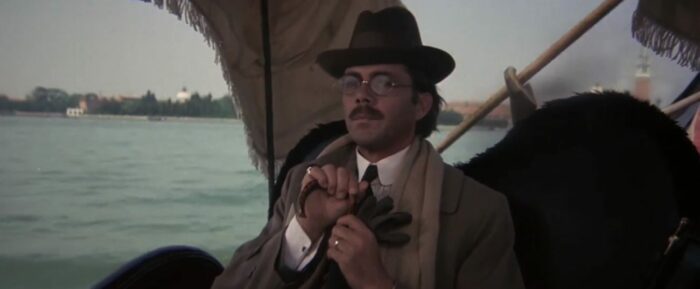
Gustav notices an hourglass reminding him about the one they used to have in his father’s house:
The aperture through which the sand runs is so tiny that… that first it seems as if the level in the upper glass never changes. To our eyes it appears that the sand runs out only… only at the end… and until it does, it’s not worth thinking about… ’til the last moment… when there’s no more time left to think about it.
It seems that he is in that moment when the upper glass is almost empty and he has no time left to think. From the very beginning of the film, the viewer can sense Gustav’s impending demise.
This feel is emphasized by a few sinister figures Aschenbach meets on his way to Lido. The first is an old dandy, who, with the help of the make-up, is trying to look younger than he actually is. This man embodies something that is not accepting its real state, desperately trying to hold on to what’s already gone. And it looks ridiculous. Aschenbach is repulsed, but he doesn’t know yet that he will become like this man after a short while.
Another strange figure is the unlicensed gondolier who takes Gustav to Lido despite his objections. This grim gondolier reminds me of Charon taking Aschenbach across the river Acheron to the underworld.
In fact, Gustav has his own way of carrying the past. The big photograph of his dead child, and another one of his wife, who may not be dead, but it’s clear that she is not a part of his life anymore. Gustav kisses both photographs with some air of reverence before leaving for dinner.
From the flashbacks, we are able to get a glimpse of Aschenbach’s life. He has apparently achieved mastery in his work, and believes that ‘the creation of beauty and purity is a spiritual act.’ And that beauty is the product of labour. He has chosen to rely on morality, spirituality, and intellect. In his words:
The artist has to be exemplary. He must be a model of balance and strength. He cannot be ambiguous.
Alfred, on the contrary, insists that beauty belongs to the senses. He blames Aschenbach for being avoidant, mocks him for his morality and perfection, his strive for ‘wisdom, truth, human dignity.’
I almost doubt that Alfred is a real person. Not in a sense that Gustav has false memories, but that Alfred is too opposing, too harsh, and even cruel in his criticism. This is what an inner critical voice could do. He acts like a destructive force of Aschenbach’s own mind, or part of it he refuses to accept.
This emphasis on wisdom and purity is destroyed by meeting a young Polish boy, Tadzio (Björn Andrésen). In Tadzio, Aschenbach finds perfect beauty and is unable to resist it, he has to fall in love with it. He sees the beauty that is not a ‘product of labour’, but rather a spontaneous creation. It’s a product of nature.
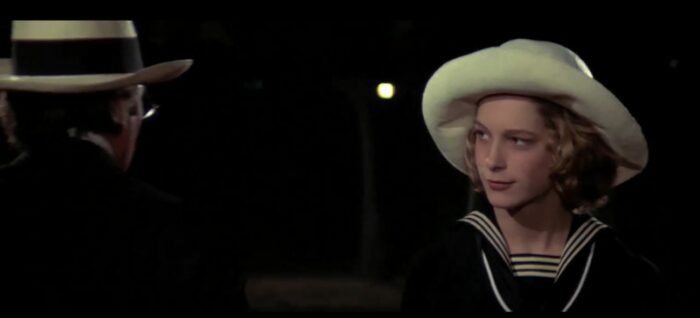
With Aschenbach’s fall, Alfred, who in the beginning was on Gustav’s side, becomes more and more confrontational. The perfect image of Tadzio becomes demonic, since beauty has no moral and is ambiguous. Anchored to this demonic force, the part represented by Alfred makes its way out of the restrictions where Aschenbach had confined it.
In Aschenbach’s case, these repressed impulses obviously include homosexuality. Being morally unacceptable to him, it takes the form of admiration of beauty, eventually leading him to fall a victim to its demonic influence. It destroys Aschenbach’s carefully established balance, towards which he was striving all his life.
Venice with its sirocco is affecting Aschenbach’s health. He even tries to leave at one point. Stays only because of the incident with his baggage. But already caught up by the influence of love and death, Aschenbach is even happy about it.
The destructive influence of Venice becomes more and more obvious with the news of cholera. Everyone in the city acts as if nothing wrong is happening. The whole city seems like acting as the dandy from the beginning of the film. If the man was masking his aging body and face under heavy make-up, the city is covering its decay under the seeming indifferent or happy appearances.
After many attempts, Aschenbach finally finds out the truth from an English clerk but chooses not to tell about it, for he is afraid that Tadzio’s family will leave. The choice Aschenbach makes, at the same time, is morally unacceptable for him, but he has no control anymore, he has no will left to make the right choice.
He knowingly falls into the abyss. And then, Aschenbach dreams of himself being booed by the public and getting the cruel reminder from Alfred about his own rejected values:
Wisdom. Truth. Human Dignity. All finished! Now there is no reason why you cannot go to your grave with your music. You have achieved perfect balance: the man and the artist are one. They have touched bottom together.
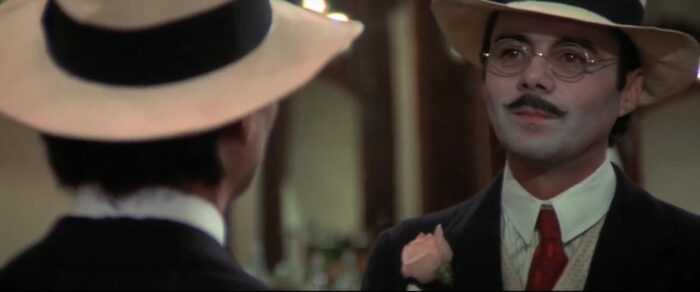
This is when Gustav changes his appearance with heavy make-up and darkened hair. He creates his mask of youth and life. But it won’t last long. Aschenbach will soon be unmasked. In the last scene, on the beach, black paint from his hair melts and runs down his face, his white make-up smears. Even his idol is defeated. Tadzio, defeated and humiliated in a fight with his friend, now shares the feeling of loneliness with Gustav, as he walks alone towards the sea. The last image of him that Gustav sees is Tadzio holding out his hand pointing somewhere in the distance, towards the sun perhaps, as if inviting Gustav to follow. And he does, he follows his ‘foreign god’—as Thomas Mann calls it.
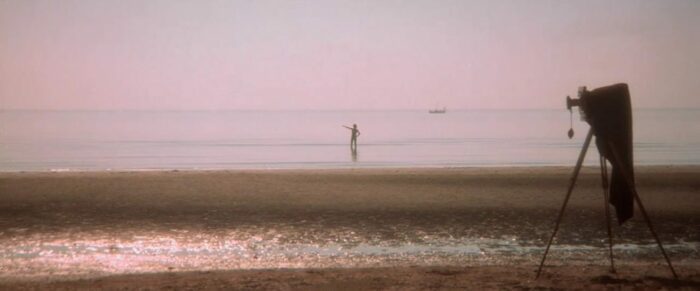
Most of the soundtrack uses the music of Gustav Mahler: Adagietto from the Fifth Symphony and the fourth part of the Third Symphony. Adagietto creates the main mood of the film: it is heard several times, including opening and ending scenes.
The choice of Mahler is not accidental, of course. There are some factual connections, like Mahler’s death being one of the inspirations for Thomas Mann to write his novella, as well as Visconti’s change of Aschenbach’s profession from writer to composer. But what seems more important to me is the music itself. It creates the most natural mood for the story, the protagonist, and his feelings. And another reason—Mahler’s music is all about relation, even the struggle between nature and man. This relation reaches perhaps its culmination in the middle of the film, when Aschenbach, excited by his lucky return to Lido and to Tadzio, feels the urge to compose. And the music he composes is a fragment from Mahler’s Third Symphony. It’s the song that uses Nietzsche’s poem “Midnight Song” from Thus Spoke Zarathustra as its lyrics.
Adagietto is Aschenbach’s music. It expresses the excitement and yearning of love, love that brings bliss as well as anguish. Mahler’s music represents the ambiguity to which Alfred referred, ‘ambiguity made a science’. It fits Alfred’s characterization of Gustav’s music—it contains everything, all the opposites, good and evil, demonic and divine. However, in Mahler’s symphonies the man, the hero usually wins, and the final parts are celebrations of life. But they also contain darkness. Death and rebirth is the theme that runs across all his work. And I would say, rather than avoiding death, Mahler repeatedly, in each of his works, goes through death and rebirth.
This story has yet another level of understanding. Aschenbach’s death may be viewed in parallel to the demise of the culture he represents. Aschenbach is described in Mann’s novella as a typical representative of his generation, his culture. He has more or less successfully shoved away his senses and instincts in the deeper layers of his psyche, falsely believing that he could dominate it with his intellect or spirit.
The old order, the old way of living is on the way to its destruction. Mann’s novella feels like a premonition of war that would start just three years after it was written. Surely there must have been a growing atmosphere of war in Europe. It is present in the film as well—when Aschenbach’s ship is entering Venice, at the beginning of the film, there are soldiers marching on the shore. We already know what this and the next war brought to Germany, Europe, or the world.
Until the war started, I can imagine, many kept going as if nothing wrong was happening. But the disease and death creep upon those who do not want to see or who are almost happy to accept them. This was the world of Thomas Mann and Gustav von Aschenbach. What was it like for Visconti 60 years later? Did the world, and the Western world especially in this case, keep its habit to look away?
I guess it did, as people usually do. And I would say, the pattern keeps repeating another 50 years later. But as someone in my dream once told me: “the world will be saved as long as there are still people who play Mahler.”
Let’s hope…

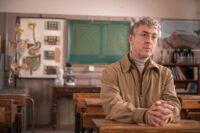

beautiful film and brilliant essay
bravo